Design House Adjustable Closet Rod
When I started out in the building business, interest rates were low, money was easy to borrow, and custom homes were the way to go. But six years later, in the early 1980s, that all changed. Interest rates went over 15%. No one could afford, let alone qualify, for a loan. Economics and demand dragged us into multi-family housing—we started installing finish work on apartment complexes, condominiums, and townhouses. The work was hard, the prices competitive, but the profits were good if you had your act together, if you were fast and didn't make mistakes.
Five or six years later, I was glad when the custom home business came back with a roar. But I wouldn't trade what I learned from those 200-plus unit buildings, not a bit of it. Our approach to every high-end custom job—from the big ones to the little ones, and our profit margins—still depends on the lessons learned from production work. And installing closet shelving is a perfect example.
When it comes to installing closet shelving, if your crew isn't following a manual of practice—a system that simplifies repetitive tasks, eliminates needless steps, and speeds installation time—then you'll never enjoy the profits that can be made in closets. Once the exterior doors are in, before installing any interior doors or trim, we like to get the closet shelving in place, if it's paintgrade. It's just easier to work in a closet without the doors in the way, and besides, that way we don't have to worry about banging shelving into new doors. We wait to install the baseboard until all the shelving is in, too, because the baseboard has to be cut around the dividers.
Closet Design
Laying out and installing closet shelving used to be simple—you just installed a single shelf and pole in every closet, about 66 in. from the floor, so a dress wouldn't drag on the carpet. Maybe people didn't have so many clothes back then.
Today, closet design is an important part of construction, but designing closet shelving doesn't have to be a brain-twister. Though closets seem to come in many different sizes and shapes, they're actually limited to only two basic types: walk-in closets, and reach-in closets.
Control Closet Design
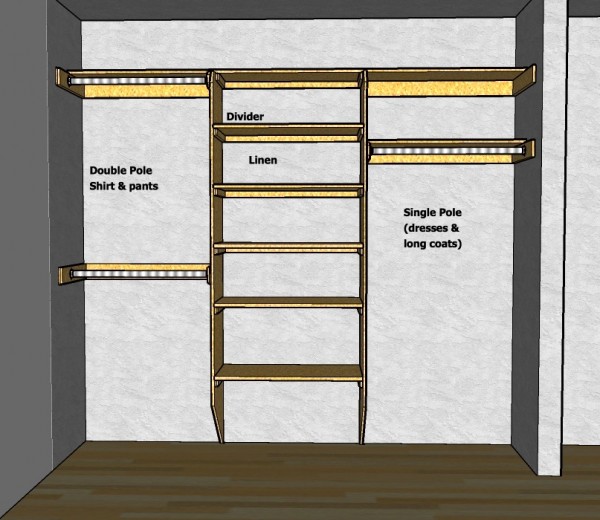
(Click any image to enlarge.)
No matter how high-end a home, the closets always share a lot in common—at least the ones outside the master bedroom. After all, there are only so many possible configurations. The three most common types of shelving arrangements are (see image, above): Double Pole, Single Pole, and Linen Shelves. We try to include a little of each in every closet, and we use 15 1/2 in. dividers to separate and help support the shelving.
To allow enough room for medium-length coats and shirttails, Double Pole should be spaced a minimum of 40 in. from the floor, and 40 in. apart. That puts the top of the 1×4 cleats at 42 in. and 84 in. from the floor (see image, below). We angle-cut our dividers, leaving a 1-in. toe on the floor, so it's easier to get a vacuum near the wall. Whether the customer wants wood, melamine, or MDF shelving, we limit the span—anything over 34 in. will sag without a support.
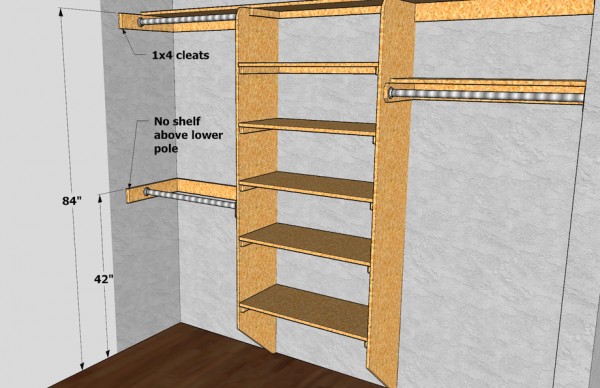
Single Pole is meant for dresses and long coats. It must be installed at least 66 in. from the floor, farther for tall clients. To secure the pole and the rosettes, we use 1×4 cleats to support all closet poles. For linen shelving, we use 1×2 cleats.
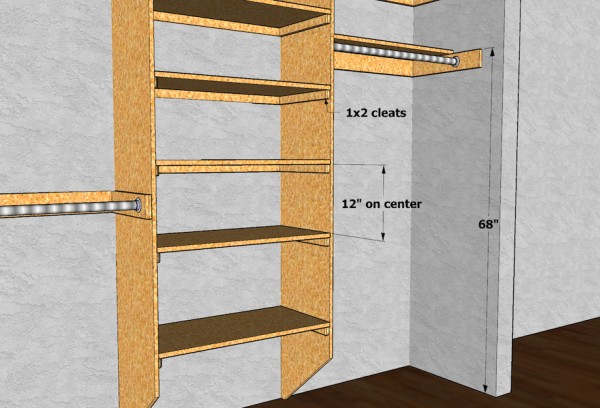
This shelving arrangement is a catchall—it's not meant just for bedding: shirts, sweaters, sports clothing, and even toys will end up on these shelves. To keep closets uniform and easier to install, we keep to the same layout—12 in. on center for all but the bottom two shelves.
Blankets and boxes need more space, so we put the first linen shelf at 18 in. from the floor, and the second one 15 in. higher, for boots or tall toys.
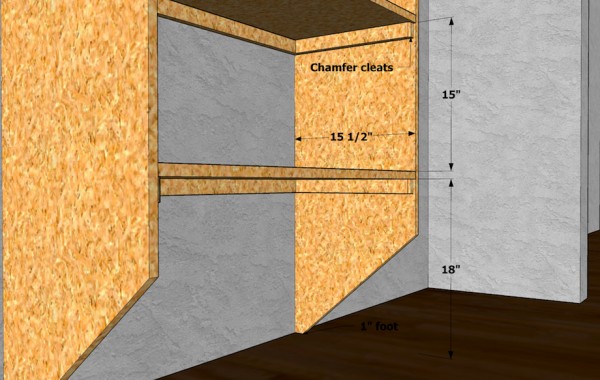
The top shelf is usually above the door header, which means that, in a 24-in. deep closet, it's tough to get anything up there.
Even though the dividers are 15 1/2 in. deep (so they'll support the poles!), we install a 12 in. top shelf, and radius or angle-cut the tops of the dividers.
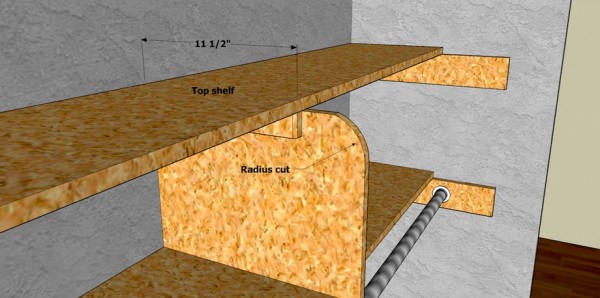
These simple design rules apply to even the most complicated closets, from reach-ins, like the one in the previous illustrations, to elaborate walk-ins, like the one below. Just remember one thing whenever you turn a corner with shelving: All closet poles require a minimum 24 in. clearance before the next divider, otherwise there won't be enough room to slide clothes into the corner.
Walk-in closets, and long reach-ins, pose a problem when it comes to shelves sagging, too. The best solution is another design strategy: eliminate mid-span supports on linen shelves by limiting their span to 32 in., then let the closet poles run longer. After all, metal supports for single and double pole are easy to install, but installing supports for linen shelving isn't so easy, and there are a lot more shelves!
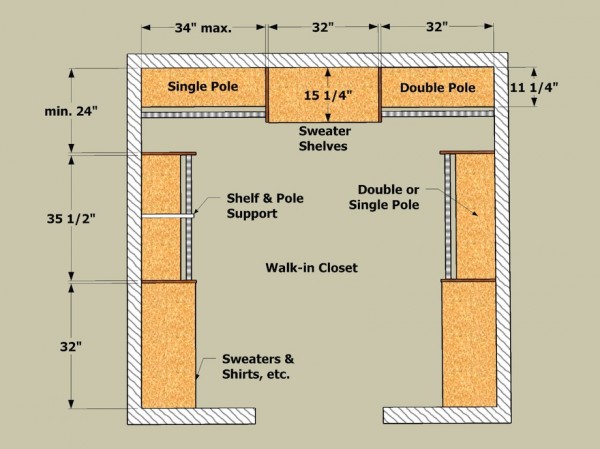
A not-so-simple story pole
Obviously, the trick to making money in closet organizers is being organized yourself, and that starts with the design. Once you've controlled and simplified the design, control and simplify the layout and installation, too—teach your crew how to make and use a story pole for every job.
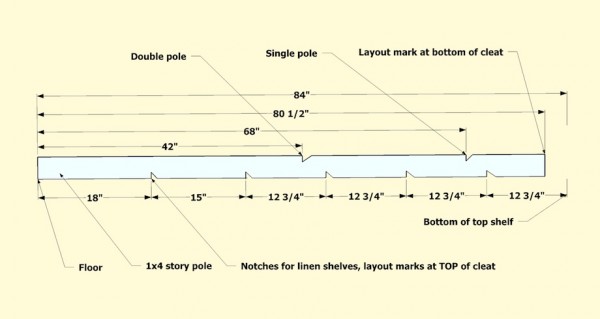
It's a fact of life: the more times your carpenters pull out a tape measure, the more mistakes they'll make, the slower they'll work, and the less profit they'll produce. There's hardly a carpentry layout task that doesn't benefit from the use of a story pole.
Make closet story poles from a piece of durable 1×4, and don't just pencil the marks—cut notches so the pole can be used from job to job.
Make all the notches at the top of the support cleats, except the top cleat! Instead, cut the story pole 3 1/2 in. short, so the mark for the top shelf—made by striking a pencil across the top of the story pole—will be at the bottom of the cleat; that way, your carpenter won't have to climb a ladder to see the top shelf mark.
With good design control and a story pole, a single carpenter can lay out all the closets in a typical home in less than one hour, and even make a cut list, too. Whenever possible, we try to keep linen shelves the same width, so they can be cut in packages. The same with Double Pole arrangements, especially if there are several closets of roughly the same size. That way, only one special measurement needs to be made in each closet. But I'll save that subject for another day.
Important Closet Requirements
Single Shelf-and-Pole: To accommodate long coats and dresses, a section of Single Shelf-and-Pole should be installed in every closet (closets for children are often an exception). To keep dresses and coats from dragging on the floor, install Single Shelf-and-Pole at least 66 in. from the floor—take the measurement from the bottom of the shelf (that puts the pole at about 64 in. from the floor). For exceptionally tall people, increase the height to keep long clothes off the floor.
Double Pole: If pants are folded over a hanger, they only need half the hanging height as a long dress—about 34 in. from the bottom of the shelf to the floor. Shirts are longer and require 40 in. from the bottom of the shelf. Because most of the clothes in our closets today are pants and shirts, Double Shelf-and-Pole should predominate in every closet, which doubles the storage space. To make the job of installing shelves easier and to allow homeowners the choice of changing the arrangement of their clothes, I separate all Double Poles by 42 in., which makes the top shelf 84 in. from the floor.
The Top Shelf: The top shelf should run completely across the closet, and around all three walls in a u-shaped closet, so the same 84-in. height determines the second or top shelf over a Single Shelf-and-Pole, too (see diagram, above). In most 8-ft. closets, 12 in. of space remains between the top shelf and the ceiling, which is enough room for shoe boxes, hat boxes and other storage.
Sweater Shelves: A typical bank of sweater shelves should begin 16 in. from the floor, which allows room for tall boots on the floor. Succeeding shelves should be spaced about 12 in. apart. If the top shelf is installed at 84 in. from the floor, this sweater shelf arrangement should result in a somewhat even spacing.
Shoe Shelves: Shoes only require about 7 in. of height (that includes high-tops and pumps). To get the most from your closet space, design shelving specifically for shoes and don't rely on 12-in.-spaced shelves for shoe storage. An 84-in. tall bank of shelves, with the first shelf 16 in. from the floor, can include 4 shoe shelves and 3 sweater shelves (see diagram). Of course, if there's room, and you're expecting a lot of shoes, build an entire bank of shoe shelves.
The only shelf in a closet that won't align horizontally with other shelves is the Single Shelf-and-Pole, because it's set at 68 in. from the floor. The 16-in. space between the Single Shelf-and-Pole and the top shelf can be divided again by an additional shelf, which creates a perfect location for a few pairs of shoes.
(This article originally appeared on GaryMKatz.com)
Design House Adjustable Closet Rod
Source: https://www.thisiscarpentry.com/2011/09/30/closet-shelving-layout-design/
0 Response to "Design House Adjustable Closet Rod"
Post a Comment